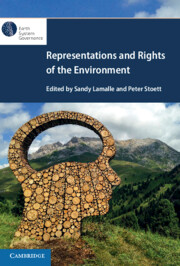Book contents
- Representations and Rights of the Environment
- Series page
- Representations and Rights of the Environment
- Copyright page
- Dedication
- Epigraph
- Contents
- Illustrations
- Tables
- Contributors
- Preface
- Acknowledgements
- 1 An Introduction
- Part I Challenges
- 2 Environmental Humanities
- 3 Decolonising the Dialogue on Climate Change
- 4 Our Relationship with the Land
- 5 A Common Space of Legal Communication
- Part II Recollection
- Part III Perspectives
- Index
- References
5 - A Common Space of Legal Communication
from Part I - Challenges
Published online by Cambridge University Press: 16 March 2023
- Representations and Rights of the Environment
- Series page
- Representations and Rights of the Environment
- Copyright page
- Dedication
- Epigraph
- Contents
- Illustrations
- Tables
- Contributors
- Preface
- Acknowledgements
- 1 An Introduction
- Part I Challenges
- 2 Environmental Humanities
- 3 Decolonising the Dialogue on Climate Change
- 4 Our Relationship with the Land
- 5 A Common Space of Legal Communication
- Part II Recollection
- Part III Perspectives
- Index
- References
Summary
Engaging with Indigenous legal traditions brings to light the existence of different forms of legal conscience. The Indigenous legal traditions catalyse both the ontological questioning and its response. And they also offer a response to the critique of law and the evolution of legal practice. Approaching different legal traditions requires, however, a change of perspective. This reflection considers the insights of anthropology, linguistics, literature, translation and semiotics as applied to law. Towards a ‘shared framework’ and ‘common legal sense’, the semiotic approach enables us to visualise the legal landscape, beyond the borders of modern constituted forms, on a wider horizon of legal communication. It allows us to approach the narrative semiotics of different legal traditions, such as the dances, storytelling, artefacts like Wampum belts and protocols for ceremonies in Indigenous law. Furthermore, reconnecting legal traditions contributes to recalling, re-embodying and reconnecting the legal subject with the more-than-human realm – reconstituting the legal experience in its integrity. Beyond the operation of translation, what is at stake in the evolution of the legal language and practice is the constitution of a common semiotic space, a space of legal communication and understanding.
Keywords
- Type
- Chapter
- Information
- Representations and Rights of the Environment , pp. 110 - 144Publisher: Cambridge University PressPrint publication year: 2023



